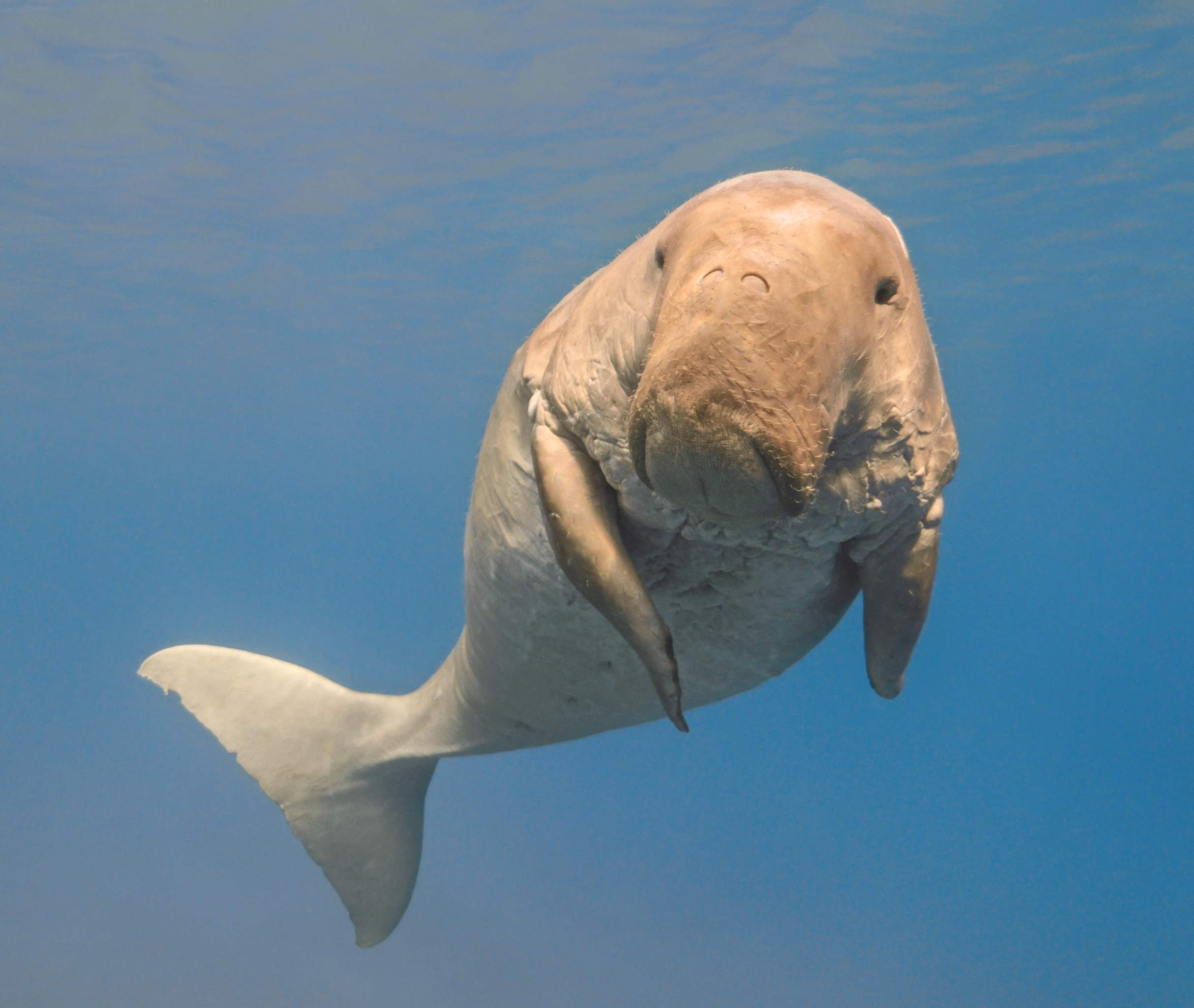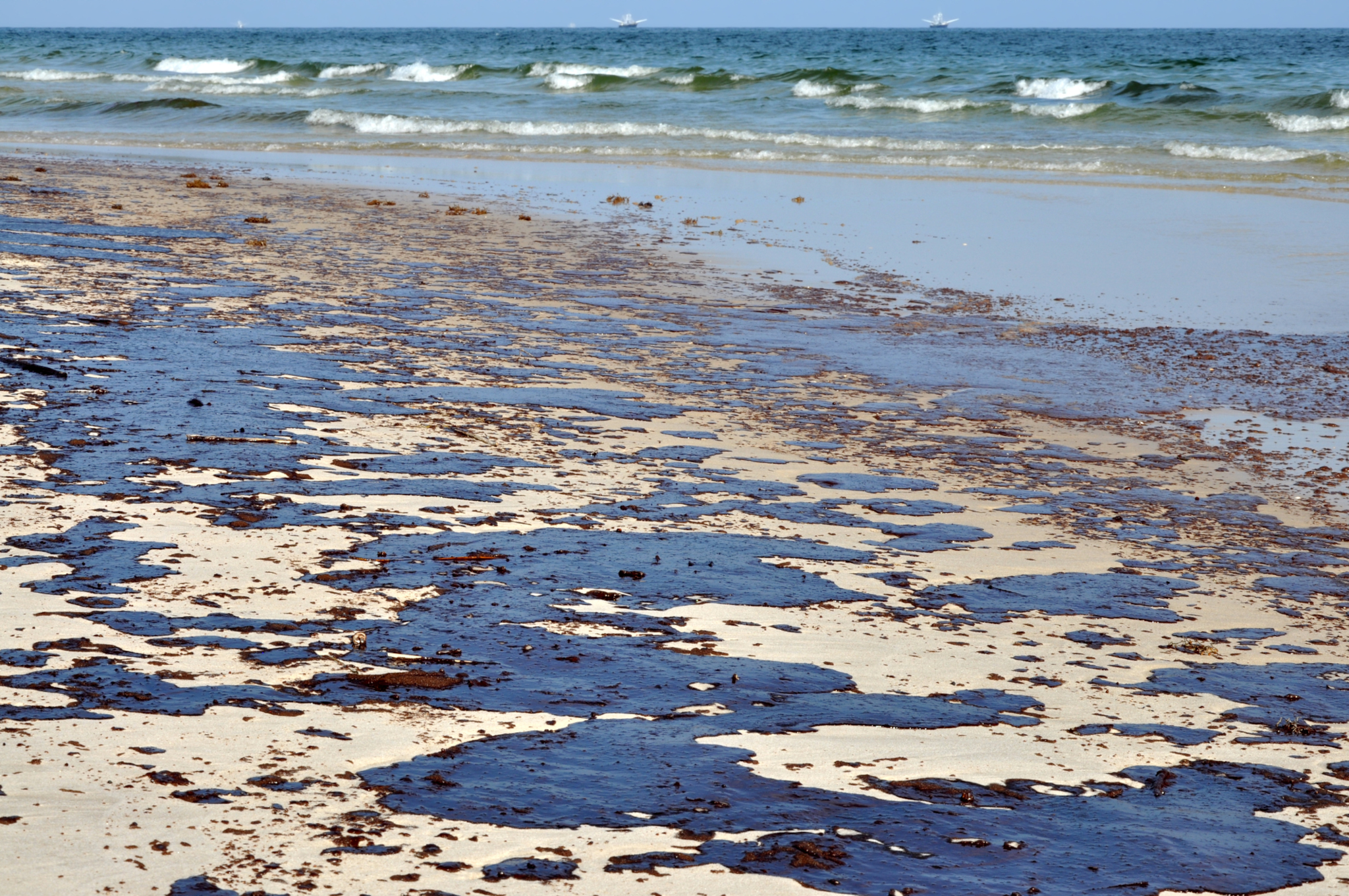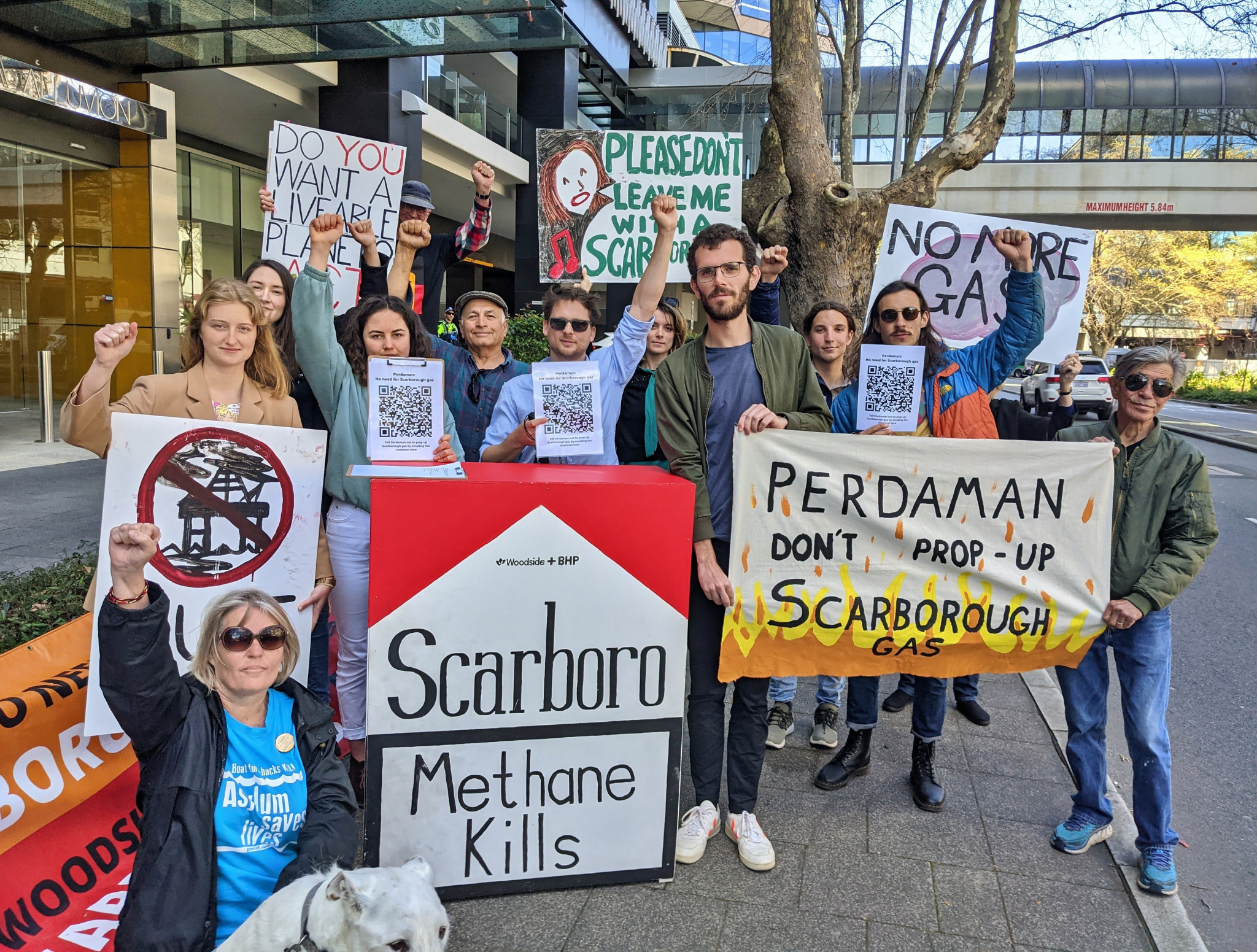Scarborough Gas Field and Burrup Hub
Location:
Burrup Peninsula, State of Western Australia, AustraliaProject risks:
Environmental Destruction, Social HarmCompanies:
- Woodside Energy Group Ltd
- Global Infrastructure Partners
- Shell plc
- BP plc
- Mitsubishi Corporation
- Mitsui & Co Ltd
- PetroChina Company Ltd
- China National Petroleum Corporation (CNPC)
- Chevron Corporation
- China National Offshore Oil Corporation
- CNOOC Ltd
- The Kansai Electric Power Company Inc (KEPCO)
- Sumitomo Corporation
- Sojitz Corporation
- JERA Co Inc
- Tokyo Electric Power Company Holdings Inc (TEPCO)
- Chubu Electric Power Company Inc
Location of the Burrup Hub. By zooming in, you can recognize the gas facilities.
Gas Producers Move Fast to Destroy Aboriginal Heritage and Underwater Life
Unless it is stopped, a gas project with a 50-year life span will destroy 40,000-year-old Aboriginal rock art.[1][2] The project also threatens dolphins, whales and magnificent coral reefs.15165 In Australia’s remote North-West on the Burrup Peninsula, Australian company Woodside wants to start up the country’s most emission-heavy new fossil fuel project: Burrup Hub.1516515163
Burrup Hub is one of Woodside's most important projects. The company and its gas partners want to develop 2 new gas fields off the nearby shore: Scarborough and Browse.1516715169 They also plan to build 2 pipelines from the gas fields to 2 already existing liquefied natural gas (LNG) terminals on the coast.[7][8][9] Burrup Hub would add to Woodside’s 2 operating offshore gas fields North West Shelf and Pluto.[10] Woodside also wants to extend North West Shelf’s lifetime until 2070.[11]
Notes on methodology: Reputational risk projects on GOGEL are updated annually. This article was last updated November 5 2024.
In November 2021, Woodside made its final investment decision to develop the first component of the Burrup Hub: Scarborough Gas Field.[12] 375 km (233 mi) off the coast, Woodside plans to drill 8 wells into the seafloor.[13] Besides Woodside, the Australian company BHP has long been an avid proponent of the Burrup hub projects. However, as of 1 June 2022, Woodside took over the entirety of BHP’s oil and gas business, including its stake in the Burrup hub endeavor. Woodside and its remaining partners want to produce gas from Scarborough by 2026.[14] They would pump the gas through a 430 km (267 mi) long pipeline to the onshore Pluto LNG terminal.[15] In this facility, Woodside would cool the gas down to -162 °C (-259.6 °F) to liquefy it.[16] Woodside has also started expanding the existing Pluto LNG facility to double its current size.[17] Enormous carriers would then ship the Scarborough gas in liquefied form from Pluto LNG to Asia and even as far as Europe.[18][19] The most important buyers of this fossil gas are German utilities RWE and Fortum’s Uniper as well as Australian fertilizer producer Perdaman Industries.[20][21][22] Uniper, RWE and Perdaman give Woodside financial security.[23]15171 Without them, the project might not have moved ahead.15173 However, there is increasing certainty about gas and oil consumption peaking from 2030 and gas being in oversupply, meaning Scarborough might not pay off in the long term.122971941819419

Scarborough Endangers Animals Every Step Along the Way
At Scarborough, Woodside wants to produce gas exactly where turtles, sea snakes, dugongs, sawfish, dolphins, whales and sharks glide through the sea.[27] The company’s quest for gas is putting these sea creatures and their home at risk.
Before Woodside is able to produce gas from Scarborough, it needs to detect the exact location and measure the size of the gas reserve.[28] To do so, the company wants to conduct numerous seismic surveys throughout 2023.[29] Woodside's seismic surveys will blast soundwaves to the bottom of the ocean every 8-15 seconds for 80 days.[30][31] These activities are a nightmare for whales, dugongs, dolphins and other underwater creatures. The blasts are as loud as a rocket launch.[33] They stop the animals from eating and mating.[34] Animals can lose their orientation and hearing.[35][36] Some may even die from the blasts.[37]

To make space for the gas wells, Woodside plans to scrape millions of tons of corals, rocks, mud and clay from the seabed.[38] The company wants to dump the material in the Dampier Archipelago, a group of 42 islands in the Indian Ocean.[39][40] The Archipelago’s biodiversity is as rich as the Great Barrier Reef’s.[41][42] Colorful coral reefs, sponge gardens and sea grass meadows cover the seafloor of the Dampier Archipelago.[43] More than 650 fish species swim through this underwater world.[44] Islands with sandy beaches and mangroves rise from the turquoise sea.[45] For Woodside, this paradise is merely a place to dump its waste.
Woodside’s gas pipeline would cut through the protected Montebello Marine Park.[46] Whale sharks – the largest fish species alive – hunt for food here.[47][48] Every year between June and November, humpback whales travel through the Park.[49] The mammals cross it as they swim north where they will have their young and raise them.[50] Generations of humpback whales have used this same route for thousands of years.[51] Loud noises from seismic tests, pipeline laying and industrial activities would quickly disorientate the whales, potentially leading them off path.[52]
Scarborough is only the first component of Woodside’s massive Burrup Hub project.[53] If the second planned gas field – Browse – goes ahead, Woodside will drill 54 wells in and around the unique Scott Reef.[54][55] It is the largest reef in Western Australia and home to over 700 fish species, many of them on the IUCN’s (International Union for Conservation of Nature) red list.[56][57]

The day-to-day operation of Woodside’s project would already be disastrous for the coral reefs, dolphins, dugongs, whales, turtles and all other animals. But if a gas spill were to occur, marine life would be directly in the firing line.[59] Woodside has proved its unreliability time and again. In 2016, the company spilled oil off the coast of the Burrup Peninsula. Woodside could not stop the spill for 2 months.[61] Adding to the disaster, the company only informed the public more than a year later.[62]

Woodside’s Acidic Emissions Erase Traces of Humankind
Woodside's huge gas project would also destroy the world’s oldest Aboriginal rock art.[63] The Pluto LNG terminal is located on the Burrup Peninsula.[64] This Peninsula is of immeasurable value to Australia’s Indigenous folk.[65] They call the Burrup Peninsula Murujuga.[66] In their traditional Ngayarda languages, Murujuga stands for “hip bone sticking out” and describes the shape of the Peninsula.[67]
Murujuga is the only place on Earth where people continuously recorded their story and changing environment through art.[68] More than 40,000 years ago, Aboriginal people carved over 1 million drawings on cliffs and stones.[69] They drew their stories, customs and everyday life: Aboriginal ceremonies, long extinct animals like the Tasmanian tiger, the very first sightings of European ships and road maps to navigate to sacred sites.[70][71][72] It is here that archeologists have found the world’s oldest image of a human face.[73]
Today, Murujuga is one of the oldest and largest areas of Aboriginal rock art on Earth.[74] The “stories from the stones” may be thousands of years old, but their importance to Aboriginal peoples has only grown.[75] The rock art ties them to their histories, customs and knowledge of their land and resources.[76] It connects them to the events and people of their past and is the base of their beliefs today.[77]
Woodside’s Scarborough project could erase this sacred Aboriginal art gallery. Already in 2006 and 2007, Woodside removed 941 rocks with carvings to make space for Pluto LNG.[79] Now, Woodside’s emissions are threatening the rock art’s very existence.[80] Its Pluto LNG terminal fouls the air with nitrogen oxides.[81] As small particles, the nitrogen oxides settle on the rocks and make their surface more acidic.[82] Over time, they dissolve the outer layer of the rocks.[83] This layer has protected the Aboriginal art for millennia.[84] Without the outer protective layer, it is only a matter of time until Woodside’s acidic emissions eat away the drawings forever.[85]
In July 2020, archeologists also discovered a unique cultural landscape off the coast of the Burrup Peninsula.[86] They found hundreds of Aboriginal stone tools and grindstones on the seabed.[87]
These are from a time when sea levels were lower and Aboriginal people lived in this area.[88] The find was yet another proof of the Burrup Peninsula and its surrounding waters' archeological significance.
Experts have pressured the Australian government for years to protect both Aboriginal legacies as World Heritage Sites.[89] Officially nominated for consideration by the Australian Government in January 2023, UNESCO’s decision on their World Heritage status remains pending.19420[90] 15119 Without official recognition of Murujuga and the underwater cultural landscape as Sites of World Heritage, Woodside can continue to threaten these unique pieces of humanity's history.
"This is our pyramids of Egypt, right here in the Burrup, and it's been there for years and years."
Aboriginal Ngarluma woman Camelia Samson when she spoke out against Woodside’s project.[78]

Australia’s Most Polluting New Fossil Fuel Project
Scarborough alone would release as much greenhouse gas emissions as 20,000 planes flying around the world every day for the next 25 years.[91] Over its lifetime, total emissions from the whole Burrup Hub would be 11 times higher than Australia’s total annual carbon emissions.[92] Woodside claims that the Scarborough project could help replace coal with gas in Asia and thereby reduce the continent’s greenhouse gas emissions. After a study commissioned by the company itself dismissed this claim, the company tried to hide the findings from the public. Only thanks to the tireless work of journalists did the report finally come out.12299
To stop Woodside’s climate-killing project, NGOs and activists have engaged in a tireless resistance campaign.[93] Thousands of people have fought Woodside with blockades and protests on the streets.[94] Faced with increasing opposition, Woodside has now shifted its tactics towards suing activists and critics of its projects.19421 Its own shareholders, including some of the world's biggest investment funds such as AustralianSuper, are also beginning to turn their backs on the company's weak climate claims.19422 At Woodside's 2024 annual general meetingm, shareholders overwhelmingly rejected the company's climate strategy for being too weak.1942419425 Woodside may soon be forced to face its own responsibility for the carbon footprint associated with the combustion of its fossil fuel products (the so-called scope 3 emissions), which the company and the wider industry have conveniently ignored up until now.15127 Moreover, the Australian Green party opposes Woodside’s project. It has vowed to use its balance power in parliament to end Australian fossil projects.12303
The Traditional Owners of Murujuga are demanding that Woodside halts investments in the project until they can give their free, prior and informed consent. Woodside has made indigenous organizations economically dependent on the company. So-called gag clauses in the funding agreements prevents people from speaking up.1230515129 While the indigenous people of Murujuga struggle to free themselves from Woodside’s grip, the company continues to develop its monstrous gas project.
Woodside wants to turn Western Australia’s iconic underwater world into industrial landscape, and sacred Aboriginal art into nothing but rocks. Construction has only just started at Scarborough. There is still time to stop Woodside.

Groups working on Scarborough and Burrup Hub: Save the Burrup – Save our Songlines, CCWA, Clean State, 350 Australia, Greenpeace Australia, Australian Marine Conservation Society, Market Forces, Friends of Australian Rock Art, Extinction Rebellion Western Australia, Australia Institute, Sea Shepherd, Disrupt Burrup Hub
Sources: